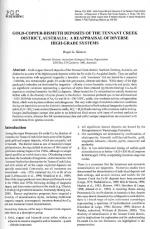Добрый день, Коллеги. Важное сообщение, просьба принять участие. Музей Ферсмана ищет помощь для реставрационных работ в помещении. Подробности по ссылке
Gold-copper-bismuth deposits of the Tennant creek district, Australia: a reappraisal of diverse high-grade systems
Gold-copper-bismuth deposits of the Tennant Creek district, Northern Territory, Australia, are distinctive as some of the highest grade deposits within the Fe-oxide Cu-Au global family. They are unified by an association with epigenetic magnetite ± hematite - rich 'ironstones' that are hosted by a sequence -I860 Ma, low metamorphic grade, Fe-oxide rich greywacke, siltstone and shale. While many of the high grade gold orebodies are dominated by magnetite - chlorite ± minor hematite, muscovite and pyrite, there are significant variations representing a spectrum of styles from reduced (pyrrhotite-bearing) Cu-Au-Bi deposits to oxidised hematitic Au-Bi(Cu) deposits. Shear-hosted Au-Cu mineralisation outside ironstones further adds to the diversity of styles present in the district. Ironstones predated syn- to late-deformational ~1825-1830 Ma introduction of Au, Cu and Bi in ~-300-350°C, acidic, low-moderate salinity or hypersaline fluids, which were in places carbonic and nitrogenous. The very wide range of oxidation-reduction conditions during ore deposition across the district is interpreted as the product of both reduced (magnetite ± pyrrhotite stable, H2S > S04=) and oxidised (hematite stable, S04= > H2S) fluids reacting with ironstones and/or mixing. Oxygen and hydrogen isotope data point to an hybrid ore fluid source with input of evolved surficial or formation waters, whereas Sm-Nd reconnaissance data and sulfur isotope compositions are consistent with contributions from igneous sources.




